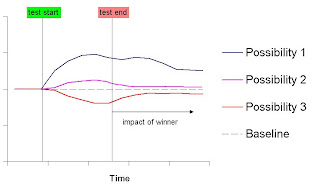
But regardless if you are the Possibility 1 or Possibility 3 you will once again plateau until you run the new and hopefully better test. And if you're good and do your industry research and customer research prior to the test so as to only test the most important learnings, you will do well, i.e. testing intelligently and not testing for the sake of testing. In any test you typically get out the quality of answers as what you put in.
However, you still won't get the full picutre. You know what you showed and you know which one of the things you showed turned out to be the success for that particular period of time. However, you don't know indirect impact of your test. How can you be sure that one of your other pages got more traffic because of a certain test element on the page you have tested? How can you be sure that the changes you saw were not due to external environment? And the list can go on... The MVT is almost there to confirm your beliefs and perhaps suprise you from time to time.
The MVT seems good, but there must be something better - something that learns on a continuum and not periodically. This is something that you see emerge in the web optimization the industry. A way to do the learnings continuously by creating a closed-loop system. It also requires a certain knowledge of yor customer and your product to yield you the best bang for your buck, however, it takes it one step further and allows your customers to tell you what they like / dislike about your entire website not just see the response for a page in question. An example of such an optimization vendor, which is very well known would be Omniture TouchClarity, now known as Test & Target 1:1. I am not here to advertise this company, but you have to give them credit for venturing into new territory. Besides looking at a particular page, they made their optimization platform very flexible, almost modular, where you now can group as many images across pages as you like to see a bigger picutre. Optimization, of course if it works, is superior to an MVT test. The whole meaning of optimization is to take the inputs and optimize or maximize to a given response, say a purchase on your site. The more well-selected imputs you have and the better you can sift through them and organize them in a meaningful manner using the optimization engine the better your optimization will be and this will consequently lead to more purchases, or your bottom line!
Of course if you have doubt in the optimization being the unfamiliar territory, you can split the traffic, if you have the luxury to do so from time to time and do some MVTs on the side to keep checking your gut feeling and the optimization model.


